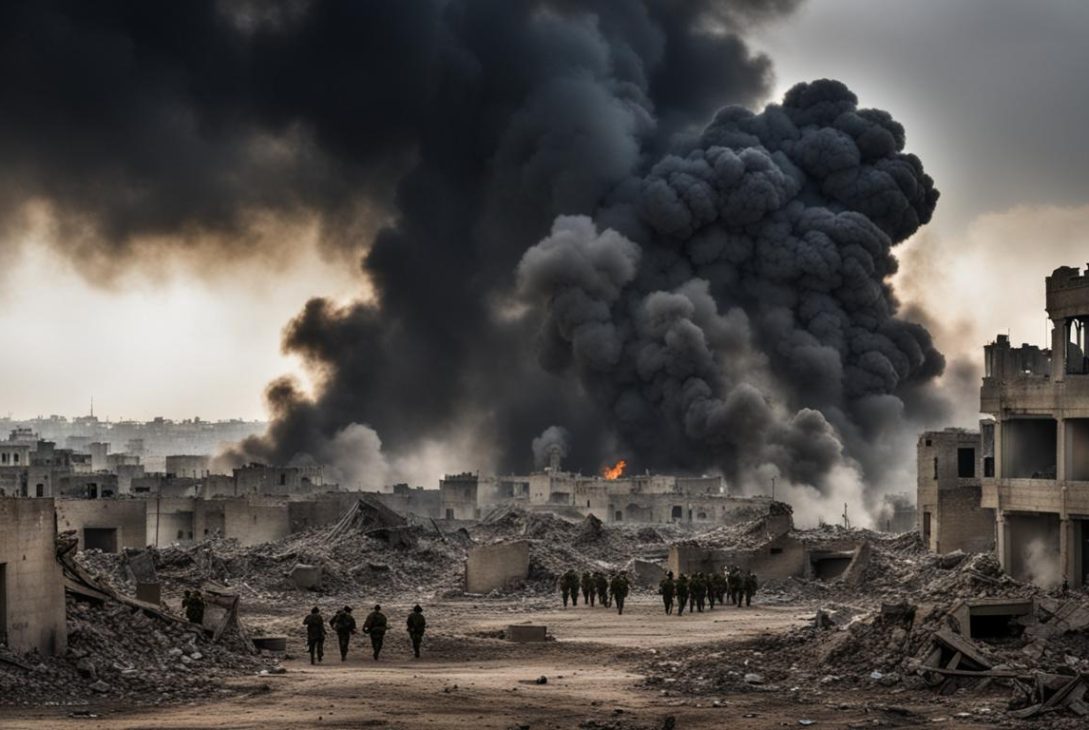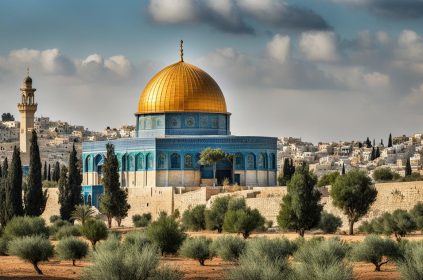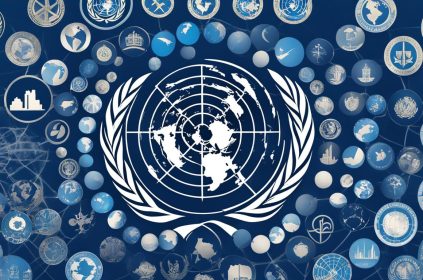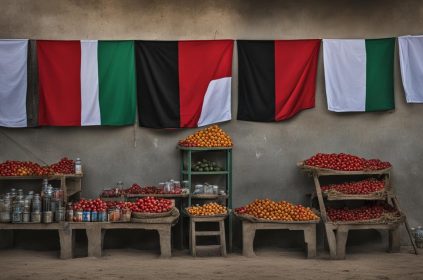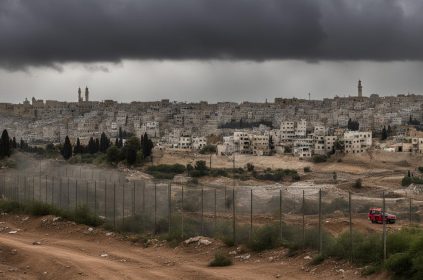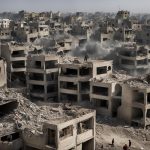The Israel Hamas war is a complex and ongoing conflict that is deeply rooted in the Israeli-Palestinian conflict and has implications for the entire Middle East. The conflict between Israel and Hamas is multifaceted, with historical, political, and religious factors contributing to the tensions. This article will delve into the complexities of this war, providing insightful analysis and factual information.
Key Takeaways:
- The Israel Hamas war is a deeply complex and multifaceted conflict.
- Understanding the historical background is crucial in unraveling the complexities of the conflict.
- Geopolitical intricacies and international involvement contribute to the complexities of the war.
- Humanitarian concerns and civilian impact are significant aspects of the conflict.
- The role of media and propaganda influence in shaping the global understanding of the conflict.
Understanding the Historical Background
The Israel Hamas war is intricately tied to the historical background of the Israeli-Palestinian conflict. The establishment of the State of Israel in 1948 and the displacement of Palestinians have created a deep sense of injustice and resentment among the Palestinian population. Hamas, classified as a terrorist organization, has capitalized on this resentment and has become a prominent player in Palestinian politics. Their aggression towards Israel further fuels the conflict and exacerbates political unrest in Palestine.
To understand the roots of the Israeli-Palestinian conflict, we must go back to the end of the British Mandate for Palestine and the subsequent partition plan proposed by the United Nations in 1947. While the plan aimed to create separate Jewish and Arab states, it was met with resistance from the Arab nations and the Arab Higher Committee. The rejection of the partition plan resulted in the First Arab-Israeli War, leading to the establishment of the State of Israel and the displacement of hundreds of thousands of Palestinians, a major catalyst for the ongoing conflict.
Hamas, formed in 1987 as an offshoot of the Muslim Brotherhood, emerged as a significant player in Palestinian politics in the late 1980s and early 1990s. Their rise to power was fueled by their resistance against perceived Israeli occupation and their ability to provide social services to the Palestinian population. However, their tactics, including suicide bombings and rocket attacks, have led to international condemnation and further complicated the path to peace.
The table below provides an overview of key events in the historical background of the Israeli-Palestinian conflict:
| Year | Event |
|---|---|
| 1947 | United Nations partition plan for Palestine |
| 1948 | Establishment of the State of Israel |
| 1967 | Six-Day War and Israel’s occupation of the West Bank and Gaza Strip |
| 1987 | Emergence of Hamas during the First Intifada |
| 1993 | Oslo Accords and the establishment of the Palestinian Authority |
Geopolitical Intricacies and International Involvement
The Israel Hamas war is not just a localized conflict, but it also involves intricate geopolitical dynamics and attracts international attention. Regional and international actors, such as Iran, Turkey, and Qatar, play a significant role in shaping the conflict. The engagement of these nations adds an additional layer of complexity to the situation. Furthermore, the conflict has led to international responses and calls for de-escalation, emphasizing its global significance.
The Middle East dynamics contribute to the complexities of the Israel Hamas war. The region has a long history of conflicts and power struggles, with various countries vying for influence and control. The Israel Hamas war is a manifestation and continuation of these dynamics, with different nations supporting different factions and pursuing their own geopolitical interests.
Iran, for example, has been a key supporter of Hamas, providing financial and military assistance. Its involvement in the conflict is driven by its anti-Israel stance and its desire to challenge Israeli and Western influence in the region. On the other hand, countries like Turkey and Qatar have expressed solidarity with the Palestinians, offering humanitarian aid and diplomatic support.
| Country | Role |
|---|---|
| Iran | Supports Hamas militarily and financially |
| Turkey | Offers diplomatic support and humanitarian aid to Palestinians |
| Qatar | Provides financial assistance and political support to Hamas |
The international community has also been actively involved in responding to the Israel Hamas war. The United Nations, for instance, has called for an immediate cease-fire and emphasized the need for a peaceful resolution. The United States, as a key ally of Israel, has expressed support for Israel’s right to defend itself while urging restraint and de-escalation. The involvement of these global actors further underscores the geopolitical intricacies and international implications of the conflict.
Overall, the Israel Hamas war is not isolated from the broader geopolitical landscape. It is influenced by Middle East dynamics and attracts international attention and involvement. Understanding these complexities is crucial in comprehending the full scope of the conflict and working towards finding a sustainable resolution.

Tactics and Challenges on the Ground
The Israel Hamas war involves a wide range of military tactics and poses significant challenges on the ground. Both Israel and Hamas employ distinct strategies in their operations, resulting in a complex and dynamic battlefield.
Hamas, as a non-state actor, relies heavily on asymmetric warfare to counter Israel’s military superiority. This includes using guerrilla tactics, such as ambushes and hit-and-run attacks, to target Israeli forces. Additionally, Hamas has built an extensive network of tunnels and underground facilities, allowing them to conduct surprise attacks and evade detection.
Israel, on the other hand, employs a combination of conventional military operations and advanced technology to neutralize Hamas’s capabilities. The Israeli Defense Forces (IDF) often conduct targeted airstrikes to destroy Hamas infrastructure and weapons stockpiles. They also utilize ground forces to neutralize Hamas operatives and disrupt their operations.
The use of asymmetric warfare and the presence of civilian populations in conflict zones present significant challenges for both sides. Hamas’s use of human shields deliberately places civilians in harm’s way, making it difficult for Israel to carry out military operations without risking civilian casualties. Israel, on the other hand, faces the challenge of conducting precise strikes while minimizing collateral damage.
| Tactic | Israel | Hamas |
|---|---|---|
| Conventional Military Operations | Utilizes advanced technology and aerial bombardments | Relies on guerrilla tactics and ambushes |
| Targeted Strikes | Destroys Hamas infrastructure and weapons stockpiles | Conceals weapons and operates from civilian areas |
| Ground Operations | Neutralizes Hamas operatives and disrupts their operations | Utilizes tunnels and underground facilities for surprise attacks |
| Challenges | Risk of civilian casualties while targeting Hamas | Uses human shields, deliberately placing civilians at risk |
“The tactics employed by both Israel and Hamas highlight the complexity of the conflict, with each side adapting their strategies to gain an advantage. The use of tunnels by Hamas and the precision strikes by Israel demonstrate the evolving nature of warfare in the region. However, the presence of civilians in conflict zones remains a significant concern, and efforts to protect non-combatants should be paramount.”
Military Operations
The Israeli Defense Forces (IDF) employ various military operations in their campaign against Hamas. These operations aim to degrade Hamas’s military capabilities and limit their ability to launch attacks against Israel.
One key operation conducted by the IDF is Operation Protective Edge, which took place in 2014. During this operation, Israel launched a series of airstrikes to target Hamas rockets and weapons caches. Additionally, the IDF initiated a ground offensive with the objective of neutralizing Hamas militants and destroying their tunnel network.
Asymmetric warfare tactics employed by Hamas, such as the use of improvised explosive devices (IEDs) and sniper fire, pose significant challenges for the IDF. The dense urban environment of the Gaza Strip further complicates military operations, often resulting in a higher risk of civilian casualties.
- Operation Protective Edge (2014)
- Airstrikes targeting Hamas rockets and weapons
- Ground offensive to neutralize militants and destroy tunnels
- Challenges for the IDF
- Asymmetric warfare tactics
- Dense urban environment increasing risk of civilian casualties
The ongoing Israel Hamas war presents complex challenges for both sides. The use of asymmetric warfare by Hamas and the need for Israel to balance military operations with the protection of civilian lives create a difficult and intricate battlefield. As the conflict continues, it is crucial to seek strategies that de-escalate tensions and protect the lives of innocent civilians caught in the crossfire.
Humanitarian Concerns and Civilian Impact
The Israel Hamas war has had a devastating impact on the humanitarian situation in the region, resulting in significant challenges and civilian casualties. The conflict has caused immense suffering among the civilian population, with thousands of lives lost and many more injured. The infrastructure in Gaza has been severely damaged, further exacerbating the humanitarian crisis.
The high number of civilian casualties is a cause for deep concern, with reports of children and innocent civilians being caught in the crossfire. This has raised questions about the proportionality of the actions taken by both sides and has led to calls for independent investigations into potential war crimes.
According to the United Nations, over 2000 Palestinians, including hundreds of children, have been killed since the start of the conflict. The toll on civilian lives is devastating and highlights the urgent need for a peaceful resolution to the conflict, prioritizing the protection of human rights and ensuring accountability for any violations.
The destruction of critical infrastructure, including hospitals, schools, and water facilities, has further compounded the humanitarian challenges in the region. The lack of access to basic services and the displacement of thousands of people have created a dire situation for the civilian population.
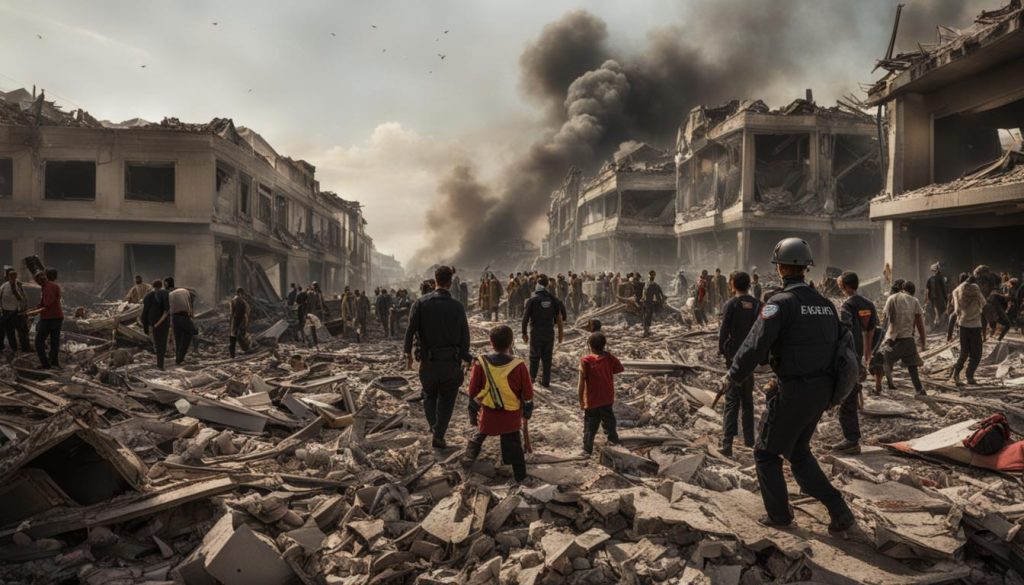
Impact on Children and the Vulnerable
Among the most vulnerable groups affected by the Israel Hamas war are children. The conflict has forced thousands of children to witness violence, experience displacement, and endure severe trauma. The long-term psychological and emotional impact on these children is a grave concern and requires urgent attention and support.
The international community, humanitarian organizations, and relevant stakeholders must prioritize the protection of civilians, provide access to essential services, and work towards a lasting ceasefire that will alleviate the humanitarian crisis. Only through concerted efforts and a commitment to human rights can the necessary steps be taken to address the challenges faced by the civilian population and pave the way for lasting peace in the region.
Media and Propaganda Influence
Media coverage and propaganda play a significant role in shaping public perceptions and international narratives surrounding the Israel Hamas conflict. The dissemination of information, images, and narratives by various media outlets contributes to the global understanding of the conflict. The impact of media coverage cannot be underestimated, as it has the power to influence public opinion and shape diplomatic efforts in addressing the war.
“Media is now the most powerful tool of war,” said Maria Ressa, an award-winning journalist. “Information warfare has become more prevalent, where both sides strategically use media to advance their agenda and control the narrative.”
This information warfare tactic is not unique to the Israel Hamas conflict. In today’s interconnected world, where information travels at lightning speed, media outlets and social media platforms become battlegrounds for competing narratives. Both Israel and Hamas engage in efforts to control the narrative, presenting information that aligns with their positions and garnering support from international audiences.
Influencing International Narratives
The media’s role in shaping international narratives is crucial. Different media outlets, influenced by their own biases and perspectives, emphasize certain aspects of the conflict while downplaying others. This leads to varying perspectives and interpretations of the situation, reinforcing existing beliefs and opinions.
International media coverage plays a significant role in how the conflict is perceived globally. The portrayal of civilians, casualties, and infrastructure damage can impact international public opinion and support for either side. This, in turn, influences international responses and diplomatic efforts to broker a resolution.
The power of media coverage highlights the need for critical analysis and independent journalism that provides a balanced and comprehensive understanding of the Israel Hamas conflict. By examining different sources and perspectives, individuals can form more informed opinions and contribute to a more nuanced dialogue surrounding the conflict.
Complexities of Cease-Fire Negotiations
Cease-fire negotiations in the Israel Hamas war are marked by a myriad of challenges and complexities. Both sides have expressed their demands and concerns, making it difficult to find common ground and reach a lasting resolution. Diplomatic efforts and peace talks have been initiated in the past, but the deeply rooted grievances and ongoing tensions between Israel and Hamas have hindered significant progress towards peace.
The cease-fire agreements between Israel and Hamas have been fragile and susceptible to frequent violations. The delicate nature of these negotiations is further complicated by the influence of external actors and their competing interests in the region. The search for a viable solution continues, as the international community plays a crucial role in facilitating dialogue and finding common ground.
Despite the challenges, diplomatic efforts remain vital in pursuing a peaceful resolution to the conflict. Continued negotiations, backed by international support and mediation, are necessary to establish a sustained cease-fire and pave the way for long-term peace. The complexities of the Israel Hamas war demand creative and inclusive approaches to address the concerns of both parties and work towards a mutually acceptable agreement.

Table: Key Cease-Fire Agreement Attempts
| Year | Attempt | Result |
|---|---|---|
| 1993 | Oslo Accords | Partial success, followed by renewed violence |
| 2005 | Israeli disengagement from Gaza | Temporarily reduced hostilities, but later escalated |
| 2012 | Pillar of Defense | Temporary cease-fire, followed by renewed violence |
| 2014 | Operation Protective Edge | Temporary truce, but tensions persisted |
| 2021 | Current negotiations | Ongoing discussions with intermittent escalations |
Broader Geopolitical Impact
The Israel Hamas war has far-reaching implications beyond the immediate conflict, significantly impacting regional stability, global security, and the dynamics of the Middle East. The ongoing tensions and violence between Israel and Hamas have created a ripple effect that extends beyond their borders. The involvement of key actors, such as Iran and Turkey, further complicates the situation and adds to the complexity of the conflict.
“The Israel Hamas war has become a focal point for regional and international powers, reflecting the broader geopolitical significance of the conflict,” says Middle East analyst Sarah Thompson. “The war not only affects the stability of the region but also has implications for global security, particularly in terms of the spread of extremism and the threat of terrorism.”
The Middle East is a region of great geopolitical importance due to its abundant oil reserves, strategic location, and historical significance. The Israel Hamas war has the potential to disrupt the delicate balance of power in the region and create a ripple effect that could impact neighboring countries and beyond. The conflict exacerbates existing tensions and rivalries, adding fuel to the fire of an already volatile region.
Furthermore, the Israel Hamas war has the potential to shape global security dynamics. The conflict has attracted significant international attention and involvement, with countries around the world taking sides and expressing their concerns. The implications of the conflict go beyond the immediate humanitarian crisis, with the potential for escalation and a wider regional conflict jeopardizing global stability.
The Geopolitical Impact: A Snapshot
| Regional Stability | Global Security | Middle East Dynamics |
|---|---|---|
| The Israel Hamas war destabilizes the already fragile region, contributing to increased tensions and the potential for further violence. | The conflict has the potential to spread extremism and terrorism, posing a threat to global security. | The dynamics of the Middle East are deeply influenced by the ongoing conflict, with the potential for realignments and shifts in alliances. |
| The conflict has the potential to spill over into neighboring countries, exacerbating existing regional rivalries and tensions. | The involvement of international actors adds a geopolitical dimension to the conflict, with the potential for wider strategic implications. | The conflict shapes the power dynamics in the Middle East, with regional players positioning themselves strategically. |
| The humanitarian crisis resulting from the war adds additional strain on resources and exacerbates existing vulnerabilities in the region. | The conflict attracts international attention and involvement, with countries taking sides and expressing concerns about the wider implications. | The conflict influences the political landscape of the Middle East, affecting regional alliances and the balance of power. |
The broader geopolitical impact of the Israel Hamas war underscores the need for a comprehensive and sustainable solution to the conflict. Regional stability, global security, and the dynamics of the Middle East are inherently interconnected, highlighting the necessity for a resolution that addresses the root causes and provides a path to lasting peace.
Prospects for Peace and Resolution
The Israel Hamas war has ravaged the region and caused immense suffering for both Israelis and Palestinians. However, despite the complexities of the conflict, there is still hope for finding a resolution and achieving enduring peace. It is crucial to address the root causes of the conflict, foster dialogue, and pursue sustainable solutions that can pave the way for a peaceful future.
One key aspect of finding a resolution is acknowledging and addressing the deep-seated grievances and historical injustices that have fueled the conflict. This requires a comprehensive approach that takes into account the aspirations and concerns of both Israelis and Palestinians. By recognizing and respecting the rights and aspirations of all parties involved, a just and lasting peace can be achieved.
Dialogue and negotiation play a vital role in resolving conflicts, and the Israel Hamas war is no exception. Sustained efforts must be made to promote meaningful discussions between all stakeholders, including Israel, Hamas, and the international community. The involvement of unbiased mediators can help facilitate dialogue and bridge the gaps between the conflicting parties.
“Peace is not absence of conflict, it is the ability to handle conflict by peaceful means.” – Ronald Reagan
Moreover, sustainable solutions that address the underlying issues must be pursued. This includes promoting economic development, improving living conditions, and ensuring equal access to resources and opportunities for all. By addressing the socio-economic disparities and promoting inclusive growth, the foundations for lasting peace can be laid.
In conclusion, while the Israel Hamas war may seem intractable, it is crucial to remain hopeful and committed to finding a resolution. By addressing the root causes, fostering dialogue, and pursuing sustainable solutions, it is possible to achieve enduring peace in the region. The international community must continue to support and facilitate the peace process, as a peaceful and prosperous Middle East is not only beneficial for Israelis and Palestinians but also for global stability and security.
| Key Points | Summary |
|---|---|
| Acknowledge grievances and historical injustices | Recognize and address the root causes of the conflict |
| Promote dialogue and negotiation | Facilitate meaningful discussions between all stakeholders |
| Pursue sustainable solutions | Address underlying socio-economic issues for lasting peace |
| International support and facilitation | Ensure global assistance in achieving a peaceful resolution |
Conclusion
The Israel Hamas war is a deeply complex and multifaceted conflict that has far-reaching implications for peace in the Middle East. Understanding the historical background, geopolitical intricacies, and humanitarian challenges is crucial in unraveling the complexities of this war.
While achieving peace and resolution may seem daunting, it is essential to continue striving for a peaceful and sustainable future in the region. Efforts towards dialogue, diplomacy, and addressing the root causes of the conflict are crucial steps in resolving the Israel Hamas war and establishing lasting peace in the Middle East.
By fostering understanding, engaging in meaningful negotiations, and promoting mutual respect, the path to peace becomes more attainable. It is imperative for all parties involved to commit to peaceful resolutions, putting an end to the violence and working towards a future where both Israelis and Palestinians can coexist in harmony.
FAQ
What is the Israel Hamas war?
The Israel Hamas war is a complex and ongoing conflict rooted in the Israeli-Palestinian conflict, involving Israel and the militant group Hamas.
What historical factors contribute to the conflict?
The establishment of the State of Israel in 1948 and the displacement of Palestinians have created a sense of injustice and resentment, contributing to the conflict.
How does Hamas play a role in the conflict?
Hamas has capitalized on Palestinian resentment and became a prominent player in Palestinian politics, fueling aggression towards Israel.
What international actors are involved in the conflict?
Regional and international actors, such as Iran, Turkey, and Qatar, play a significant role in shaping the conflict and adding complexity.
How does the conflict affect civilians?
The conflict has significant humanitarian implications, including casualties, displacement, and damage to critical infrastructure.
How does the media influence the conflict?
The media and propaganda shape public perceptions and international narratives surrounding the conflict, influencing global understanding.
Are there ongoing efforts to achieve a cease-fire?
Cease-fire negotiations face challenges due to deep grievances and tensions between the two parties, hindering significant progress.
What are the broader implications of the conflict?
The conflict affects regional stability, global security, and Middle East dynamics, with involvement from key actors like Iran and Turkey.
Is there hope for peace and resolution?
Efforts towards addressing root causes, fostering dialogue, and pursuing sustainable solutions are essential in achieving enduring peace.
Source Links
- https://www.ewmagazine.nl/buitenland/opinie/2023/11/roberta-n-haar-unraveling-the-complex-dynamics-of-u-s-policy-on-the-hamas-war-1379925/
- https://bnn.network/world/israel/the-israel-hamas-conflict-unraveling-the-complexities/
- https://bnn.network/politics/unraveling-the-complexities-of-the-israel-hamas-conflict-2/
conflict between israel and hamas gaza strip conflict hamas aggression israeli military operation isreal hamas war missile attacks in israel Unraveling the Complexities of the Israel Hamas War
Last modified: January 17, 2024


